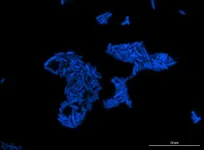Novel sensor discovered that helps bacteria detect and respond to formaldehyde
The EfgA protein directly senses elevated levels of formaldehyde and stops growth to protect cells
2021-05-26
(Press-News.org) Bacteria called methylotrophs can use methane and methanol as fuel; in doing so, they produce large amounts of formaldehyde during growth, but until recently no one knew how they detected and responded to this toxic compound. Publishing on 26th May, 2021 in the Open Access journal PLOS Biology, Christopher Marx of the University of Idaho and colleagues describe their discovery of a novel formaldehyde sensor in the bacterium Methylorubrum extorquens, and other methylotrophs.
Some may remember the pungent smell of this toxic chemical from high school dissections of formaldehyde-preserved animals. From bacteria to humans, all organisms produce at least a little formaldehyde as a byproduct of their normal metabolic processes. Methylotrophs, however, make substantially higher amounts of formaldehyde while breaking down certain one-carbon compounds, like methane and methanol, which they use as a source of both carbon and energy.
Marx and his team found the new formaldehyde sensor by growing a methylotroph on increasingly higher formaldehyde concentrations. They sequenced the genomes of bacteria that had evolved to tolerate excess formaldehyde and saw mutations in a previously unknown gene they named efgA, for "enhanced formaldehyde growth." They found that this gene occurs almost exclusively in the genomes of methylotrophs, and that the EfgA protein the gene encodes can detect formaldehyde and quickly stop bacterial growth when levels of the toxic chemical get too high. The researchers also demonstrated that inserting the efgA gene into a non-methylotroph bacterium, E. coli, allowed it to survive at higher-than-normal formaldehyde levels.
Previously, scientists had identified enzymes in all domains of life that detoxify formaldehyde. But this is the first protein sensor described in methylotrophs that can detect formaldehyde and halt growth to prevent cell damage, all without involving detoxifying enzymes. The new discovery may have applications in biotechnology; bacteria engineered to withstand high formaldehyde concentrations with the efgA gene could potentially produce pharmaceuticals and other valuable compounds while growing on methanol, a readily available industrial material.
Dr. Marx notes, "This work has been a surprising outgrowth of a simple question: what does it take for cells to grow directly on formaldehyde? Remarkably, they needed to break a sensor system rather than crank up detoxification. Work is ongoing to further understand the binding specificity of EfgA and homologous proteins as well as to try to move from a hypothetical link between EfgA and translation suggested in several ways in this paper to establishing a direct protein-protein interaction."
INFORMATION:
Research article
Peer reviewed; Experimental study; Bacteria
In your coverage please use these URLs to provide access to the freely available articles in PLOS Biology: http://journals.plos.org/plosbiology/article?id=10.1371/journal.pbio.3001208
Citation: Bazurto JV, Nayak DD, Ticak T, Davlieva M, Lee JA, Hellenbrand CN, et al. (2021) EfgA is a conserved formaldehyde sensor that leads to bacterial growth arrest in response to elevated formaldehyde. PLoS Biol 19(5): e3001208. https://doi.org/10.1371/journal.pbio.3001208
Funding: This work was supported by funding from the Army Research Office (https://www.arl.army.mil/who-we-are/aro/ ) to CJM (W911NF-12-1-0390). CJM, JSP, CJQ, and FMY were supported by the Center for Modeling Complex Interactions (https://imci.uidaho.edu/) sponsored by the National Institute of General Medical Sciences (https://www.nigms.nih.gov/ ) under award number P20 GM104420. TT, OJB, CJM, JSP and FMY were also supported by National Science Foundation (https://www.nsf.gov/ ) EPSCoR Track-II under award number OIA1736253. JVB was supported from an award from the BEACON Center for the Study of Evolution in Action (https://www3.beacon-center.org/ ) (parent NSF award DBI-0939454). DDN was supported by the Department of Organismic and Evolutionary Biology at Harvard University (https://oeb.harvard.edu/). LBL was supported by an INBRE Undergraduate Research Fellowship (https://inbre.uidaho.edu/research/) (parent NIH award P20GM103408). Computer resources were provided in part by the Institute for Bioinformatics and Evolutionary Studies Computational Resources Core (https://www.ibest.uidaho.edu/) sponsored by the National Institutes of Health (NIH P30 GM103324). This research also made use of the computational resources provided by the high-performance computing center at Idaho National Laboratory, which is supported by the Office of Nuclear Energy of the U.S. DOE and the Nuclear Science User Facilities (https://www.energy.gov/ne/office-nuclear-energy) under Contract No. DE-AC07-05ID14517. The funders had no role in study design, data collection and analysis, decision to publish, or preparation of the manuscript.
Competing Interests: The authors have declared that no competing interests exist.
[Attachments] See images for this press release:

ELSE PRESS RELEASES FROM THIS DATE:
2021-05-26
May 26, 2021, CLEVELAND: According to new findings published in Science Translational Medicine, Cleveland Clinic researchers have identified a promising drug target for treating and preventing aggressive, drug-resistant prostate cancer.
The team, led by Nima Sharifi, M.D., of Cleveland Clinic's Lerner Research Institute, demonstrated that inhibiting the protein H6PD led to significantly reduced tumor sizes and improved survival among mouse models with drug-resistant prostate cancer. The H6PD levels also were elevated in biopsied patient tumors, suggesting the protein might be targeted ...
2021-05-26
Milwaukee, May 26, 2021 - A non-opioid based target has been found to alleviate chronic touch pain and spontaneous pain in mice. Researchers at the Medical College of Wisconsin (MCW) discovered that blocking transient receptor potential canonical 5 (TRPC5) activity reversed touch pain in mouse models of sickle cell disease, migraine, chemotherapy-related pain, and surgical pain.
TRPC5 is a protein that is expressed in both mouse and human neurons that send pain signals to the spinal cord. The findings were published in Science Translational Medicine. The senior and co-first authors of the manuscript, respectively, are MCW researchers ...
2021-05-26
What if a robot could organize your closet or chop your vegetables? A sous chef in every home could someday be a reality.
Still, while advances in artificial intelligence and machine learning have made better robotics possible, there is still quite a wide gap between what humans and robots can do. Closing that gap will require overcoming a number of obstacles in robot manipulation, or the ability of robots to manipulate environments and adapt to changing stimuli.
Ph.D. candidate Jinda Cui and Jeff Trinkle, Professor and Chair of the Department of Computer Science and Engineering ...
2021-05-26
PITTSBURGH, May 26, 2021 - In a paper published today in Science Advances, researchers from the University of Pittsburgh School of Medicine showed that inhalable nanobodies targeting the spike protein of the SARS-CoV-2 coronavirus can prevent and treat severe COVID-19 in hamsters. This is the first time the nanobodies--which are similar to monoclonal antibodies but smaller in size, more stable and cheaper to produce--were tested for inhalation treatment against coronavirus infections in a pre-clinical model.
The scientists showed that low doses of an aerosolized nanobody named Pittsburgh inhalable Nanobody-21 (PiN-21) protected hamsters from the dramatic weight loss ...
2021-05-26
An inhalable nanobody-based treatment may effectively prevent and treat SARS-CoV-2 infections when administered at ultra-low doses, according to a new study in Syrian hamsters. This novel therapy, Pittsburgh inhalable Nanobody 21 (PiN-21), could provide an affordable, needle-free alternative to monoclonal antibodies for treating early infections. Sham Nambulli and colleagues recently developed PiN-21, which uses single-domain antibody fragments that are cheaper to produce than monoclonal antibodies. However, until this study, the efficacy of PiN-21 had not been reported in living organisms. To advance the development of this treatment, Nambulli et al. administered a 0.6 milligram per kilogram ...
2021-05-26
Piscine orthoreovirus (PRV) - which is associated with kidney and liver damage in Chinook salmon - is continually being transmitted between open-net salmon farms and wild juvenile Chinook salmon in British Columbia waters, according to a new genomics analysis published today in Science Advances.
The collaborative study from the University of British Columbia (UBC) and the Strategic Salmon Health Initiative (SSHI) -- a partnership between Fisheries and Oceans Canada (DFO), Genome BC and the Pacific Salmon Foundation -- traces the origins of PRV to Atlantic salmon farms in Norway and finds that the virus is now almost ubiquitous in salmon farms in B.C.
It also shows that wild Chinook salmon are more likely to be infected with ...
2021-05-26
Jodi Karnell and colleagues have developed a monoclonal antibody, VIB7734, that reduces symptom severity in people with cutaneous lupus by targeting and depleting plasmacytoid dendritic cells (pDC) in blood and skin. In two phase I clinical trials involving a total of 67 people with autoimmune diseases such as lupus, treatment with VIB7734 was as safe as a placebo and significantly reduced pDC frequencies, the researchers found. The antibody also reduced the activity of a group of key immune proteins called type 1 interferons in skin. Both pDCs and type 1 interferons are suspected ...
2021-05-26
In the human gut, good bacteria make great neighbors.
A new Northwestern University study found that specific types of gut bacteria can protect other good bacteria from cancer treatments -- mitigating harmful, drug-induced changes to the gut microbiome. By metabolizing chemotherapy drugs, the protective bacteria could temper short- and long-term side effects of treatment.
Eventually, the research could potentially lead to new dietary supplements, probiotics or engineered therapeutics to help boost cancer patients' gut health. Because chemotherapy-related microbiome changes in children are ...
2021-05-26
MOSCOW, Idaho -- May 26, 2021 -- University of Idaho researchers partnered with other scientists from the United States and Australia to study the evolution of Tasmanian devils in response to a unique transmissible cancer.
The team found that historic and ongoing evolution are widespread across the devils' genome, but there is little overlap of genes between those two timescales. These findings, published in Proceedings of the Royal Society B, suggest that if transmissible cancers occurred historically in devils, they imposed natural selection on different sets of genes.
Tasmanian devils suffer from a transmissible cancer called devil facial tumor disease (DFTD). Unlike typical cancers, tumor cells from transmissible cancers are directly transferred from one individual ...
2021-05-26
Children of Latinx immigrants who take on adult responsibilities exhibit higher levels of political activity compared with those who do not, according to University of Georgia researcher Roberto Carlos.
Immigrant communities often display low levels of political engagement, but a new study by Carlos indicates that when children of Latinx immigrants take on adult roles because of parents' long work hours, immigrant status or language deficiencies, they develop noncognitive skills associated with higher rates of political participation.
"There is thriving in spaces that we wouldn't necessarily expect because of the hardship related ...
LAST 30 PRESS RELEASES:
[Press-News.org] Novel sensor discovered that helps bacteria detect and respond to formaldehyde
The EfgA protein directly senses elevated levels of formaldehyde and stops growth to protect cells




